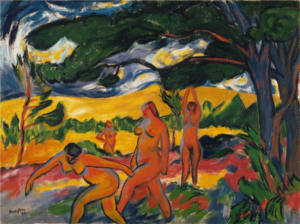
Akte im Freien, literally translated as “Nudes in the Open,” but known by the English title, “Under the Trees,” was painted by German artist Max Pechstein in 1911 as part of the German art movement Die Brücke. Die Brücke, or “The Bridge” was founded in 1905 by Erich Heckel, Ernst Ludwig Kirchner, Karl Schmidt-Rottluff, and Max Pechstein, and it is acknowledged as the birth of expressionism. Expressionism is characterized by somewhat flat figures rendered with large strokes in bold and sometimes clashing colors. The rougher brushwork and more aggressive colors are meant to challenge the existing status quo of popular art and portray a more authentic depth of feeling. Munch’s “The Scream” is the most iconic work of expressionism, though Munch himself was not part of Die Brücke.
In Germany, Die Brücke named themselves because they intended to be a bridge between the past and present. None of the four founding members had a traditional art background, reflected in their avant-garde applications of paint. However, they wanted to uphold the traditions of German art by combining classic techniques in new ways, such as experimentation with printmaking and oil paint.
In this painting, Pechstein portrays a group of four naked women in warm orange tones, milling in the shade of a dark green tree. Nudity was a common subject in the movement, as the expressionist philosophy considered it to be natural and authentic. “Under the Trees” renders the women’s faces in little detail, with most of the definition going into the lines of the body. However, the women are not in sexualized positions and seem to be going about their business, not even facing the viewer. Their bodies are emphasized as natural, rendered in the same warm tones as the sandy landscape. In this bright landscape of yellow, red, and orange, the overhanging trees provide color contrast and visual relief from the bright, hot colors. It emphasizes the peaceful element of the natural settings with deep blues and greens that seem to cool off the landscape. Trees are rare in expressionist art, but in this painting the natural setting seems to fit the free figures. It’s an intensely vivid setting that is brighter and happier than most settings in the movement. In the German title, “Freien” refers to the open air environment, but “frei” literally means free. Outside of the increasingly industrialized world, Pechstein shows figures that have embraced nature and are able to freely express themselves.
Sources:
https://www.theartstory.org/movement/die-brucke/
https://www.moma.org/collection/terms/die-brucke-the-bridge#:~:text=The%20artists’%20group%20Die%20Br%C3%BCcke,and%20provoke%20an%20emotional%20response.
